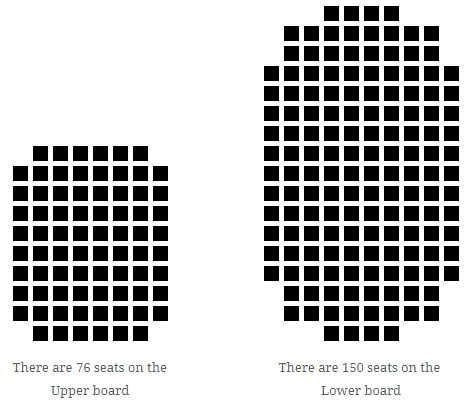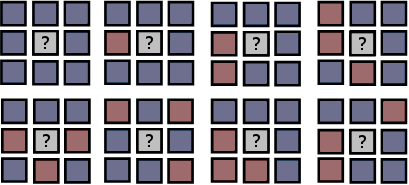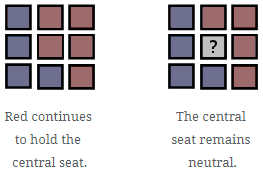Game Materials
Number of players:
There are two players. In Majority these players are referred to as the Red and the Blue players.
Pieces:
There are a number of different coloured pieces in Majority that represent the ownership of a seat by a player. These pieces are:
- 226 seat pieces – red on one side, blue on the other.
- 14 preference pieces – green on one side, yellow on the other.
Boards:
Majority is played on two boards: the Upper and Lower boards. Each board consists of a pattern of available seats. The Upper board has 76 seats and the Lower board has 150 seats. All seats begin the game as neutral and unclaimed.

Either the Upper or Lower boards may be played alone, but a complete game of Majority is played with both boards simultaneously.
Beginning the Game
Preferences:
Preferences represent seats that the player has a claim to regardless of seat claims during the game. Before the first move of the game both players may choose preferences without the other player’s knowledge. This is done by writing down the coordinates of preferences and covering each written coordinate with one preference piece.
The number of preferences each player may declare is dictated by which boards are in play:
- Up to three for the Upper board
- Up to four for the Lower board
If both boards are played each player has up to seven preferences available which may be declared on either board. For example, a player may wish to declare all seven preferences on the Upper board and none on the Lower board.
Turn Order:
Turn order does not affect the outcome of the game. However, traditionally Red is said to be established first and the Red player therefore takes the first turn.
General Play
- Each player takes a turn by claiming a seat. If the seat is not a preference the player places a seat piece displaying their colour on the chosen seat (see below: The effect of preferences).
- If a local majority is created by the claim the whole board is accessed for local majorities and seats flipped accordingly (see below Local majorities).
Local majorities:
Local majorities are created when a seat is completely surrounded by other claimed seats. As a result the ownership of the seat is challenged. The seat is flipped to the side with the greatest number of surrounding seats. For example, the following local majorities would win the centre seat for Blue:

If all surrounding seats are held equally by Red and Blue the centre seat is counted. As a result, if the centre seat is red it remains red, if it is blue it remains blue. If the centre seat is neutral, it remains neutral until the composition of the surrounding seats changes or a player claims the seat directly. For example:

Marginal Seats:
Not all seats are surrounded by eight other seats. Seats with less than eight seats in their local majorities are known as marginal seats. In total there are 76 marginal seats and 150 standard seats across both boards. The Upper board presents three types of marginal seats:
- 14 five-seat marginals
- 8 four-seat marginals
- 4 seven-seat marginals
The Lower board presents five types of marginal seats:
- 22 five-seat marginals
- 8 seven-seat marginals
- 8 six-seat marginals
- 8 four-seat marginals
- 4 three-seat marginals
Calculating majorities:
Majorities are calculated and seats flipped in the following order:
- Local majorities that benefit the creating player.
- Opponent’s beneficial local majorities.
- Absolute majorities (See below: Winning the game).
The board is reevaluated after a seat is flipped. As seats are flipped they may create new local majorities, in this case the new local majorities are also calculated and the seats flipped one at a time in the same order as stated above.
As the board changes seats may not be flipped or previously flipped seats may be flipped back to the opposing side. For example: if Red claims a seat which creates one Red local majority and one Blue local majority the Red majority is calculated first. It may be the case that as a result of the Red local majority being flipped the Blue local majority no longer exists. Similarly, if the Red local majority creates another Blue local majority which negates the Red local majority and flips the seat back to Blue, this is a legal outcome.
Finally, if two local majorities are created for the same player by the same seat claim, the claiming player may choose which of the two is calculated and flipped first.
The effect of preferences:
In general play, if a player claims a seat that is an opponent’s preference (the opponent placed a preference on that seat at the beginning of the game) the preference is placed instead of the player’s seat. The seat counts for the preference player when calculating local majorities (green for red and yellow for blue), but not towards that player’s absolute majority.
If both player’s preference claims the same seat they cancel each other out and the seat is treated as a normal neutral seat, claimed by whichever player chooses to do so. Similarly, if the seat is surrounded then it is influenced by its local majority in the same manner as any neutral seat.
The immutable preference rule:
This rule states that preferences are not influenced by local majorities. If a local majority is created around a preference seat or the seat is claimed, the seat owner remains the preference player. If the seat is not yet revealed it is revealed to be the preference colour.
Winning the Game
Absolute Majority:
A player wins the game once they have achieved an absolute majority – if every seat has been claimed and the player controls a majority of seats on the board/s.
In complete games, (employing the Upper and Lower boards) a player must control the Upper board to win. If a player has an absolute majority, but does not control a majority of seats on the Upper board the player is said to be blocked and the game is hung. Both boards are then reset and re-contested without new preferences being declared.